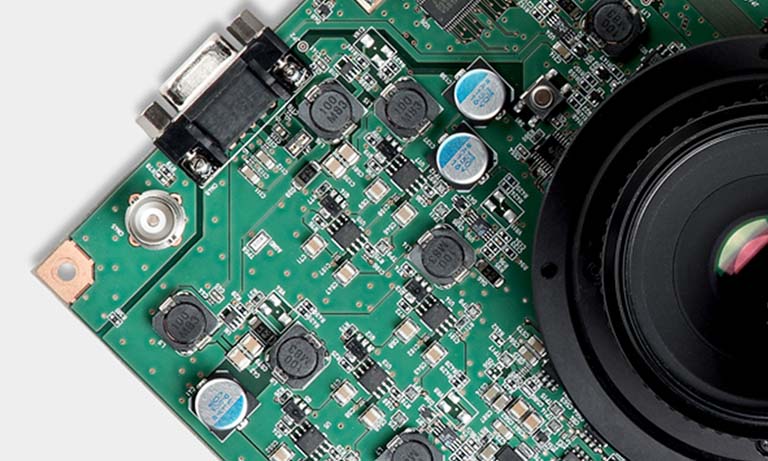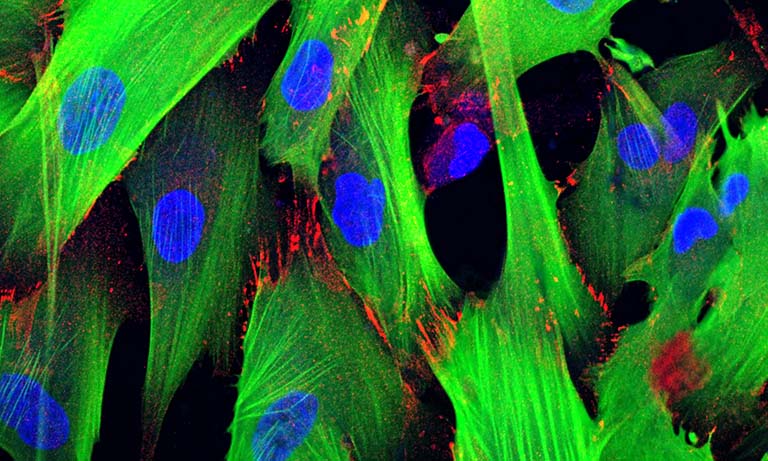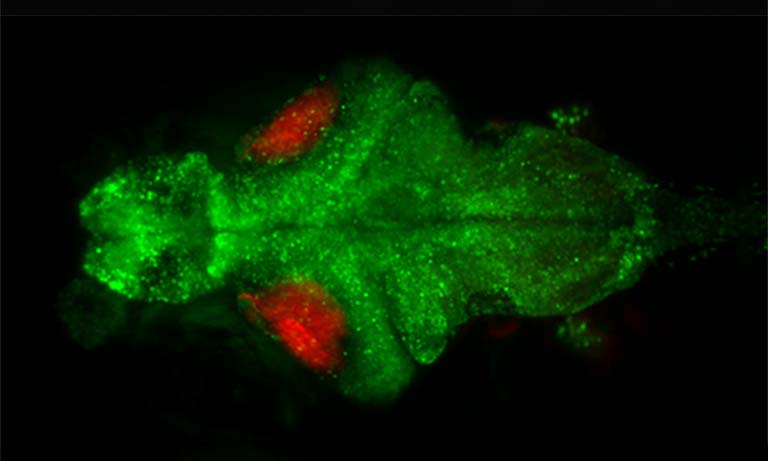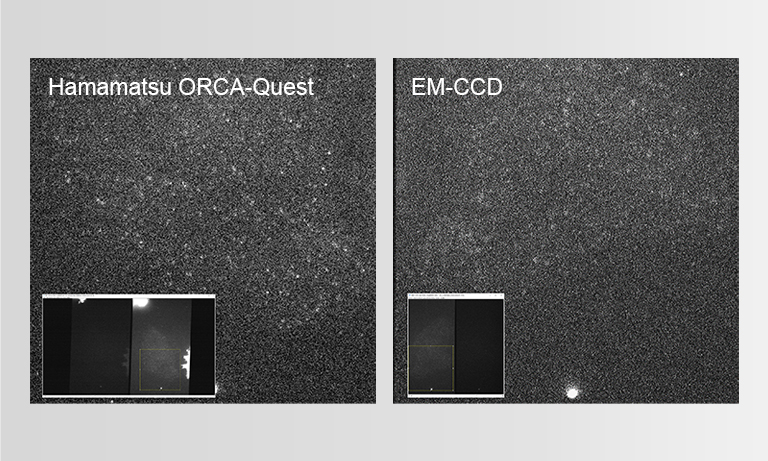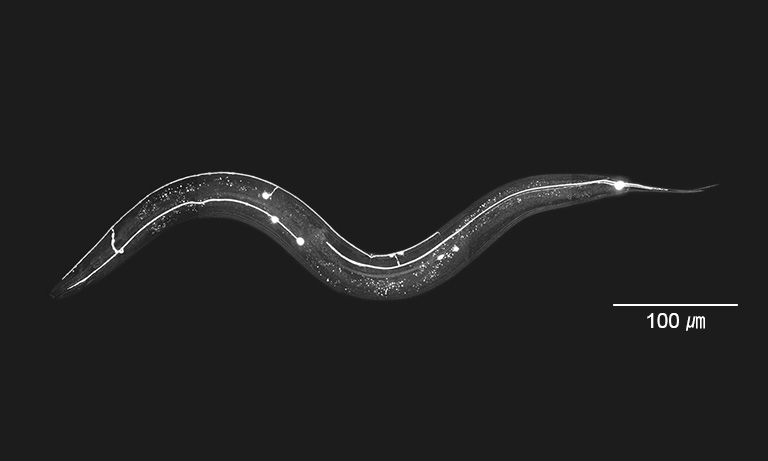United Kingdom (EN)
Select your region or country.
40Ca+ imaging by ORCA-Quest for optical clock application
Time is one of the seven basic physical quantities in physics, and it is also the physical quantity with the highest measurement accuracy. As we all know, when measuring length with a ruler, the smaller the scale of the ruler, the more precise the measurement. The same is true of the measurement of time; the higher the frequency of the oscillation of the clock, the more accurate the measurement of time tends to be. At present, scientists in the laboratory to develop the world's most accurate clock, optical clock, the system uncertainty has reached 10-18 or 10-19 magnitude, equivalent to 10 billion years of exactly one second level. Calcium ion optical clock is a member of the big family of optical clock. Compared with other members, it has distinct characteristics: the energy level structure is relatively simple, the laser frequency required is in the visible spectrum, and it can be realized by semiconductor laser. Therefore, it is easy to achieve high integration, high reliability and high running rate of the portable optical clock.
The optical clock consists of three basic parts: physical system, oscillator and counter. A physical system consists of a system of atoms, ions, or molecules that are not subject to collision or interference from the external environment. At present, the optical clock mainly refers to two physical systems: the neutral atoms trapped in the optical lattice and the single ions trapped in the ion trap. The oscillator is an ultra-narrow linewidth ultra-stable laser. The counter is used to realize the connection and transmission of light wave and microwave. It is composed of a femtosecond optical comb and a microwave clock reference. According to the reference atomic system, there are various kinds of optical clocks, of which the calcium ion optical clock is an important member.
ORCA-Quest experiment for 40Ca+ optical clock
Calcium ion is an ideal reference system for building high precision optical clocks and realizing applications. The figure on the right lists the lowest energy levels associated with a calcium optical clock. The 42S1/2 state is the ground state of the ion. The 32D state is the lowest energy ion excited state, which is also metastable, with a lifetime of about 1 s, and the natural linewidth of the 42S1/2-32D transition is about 0.14 Hz. The long lifetime (narrow natural linewidth) of the 32D state makes the 42S1/2-32D transition an ideal reference transition for the optical clock. The 42S1/2-32D5/2 transition is chosen as the reference transition for the optical clock in the experiment.
The simple principle of the calcium optical clock: first, an ion trap device is used to trap individual calcium ions using alternating electric fields, and then laser cooling is performed to slow down the movement of calcium ions. Next, an ultra-stable narrow linewidth laser is used to detect the bell transition spectrum. Finally, the femtosecond comb is used to realize the conversion from visible frequency to microwave frequency, and finally the ultra-high stability frequency output can be used directly.

Partial energy level diagram of 40Ca+ showing the principal transitions used in cooling, repumping and probing
In the process of 40Ca+ optical clock construction, the stability of 40Ca+ optical frequency standard needs to be determined by using a single-photon camera with high sensitivity to observe the captive position of calcium ions and single Ca+ fluorescence (397 nm wavelength) detection. Meanwhile, realizing the comparison of two calcium ion optical frequency standards is needed in the research process. In this process, it is necessary to use highly sensitive single-photon camera to observe ion imaging and RF photon association technology, as well as to carry out detailed research on the dynamics of calcium ions in captivity, so as to realize the optimization of the captivity system.
In previous studies, EM-CCD was mainly used for imaging, mainly because EM-CCD has imaging sensitivity at the single-photon level. With the advent of qCMOS, it attracts the attention of many researchers in optical clock field. We conducted comparative experiments in the Innovation Academy for Precision Measurement Science and Technology, Chinese Academy of Sciences.

Experimental setup
ORCA-Quest
Exposure time: 500 ms
Binning: 4×4
Scan mode : Ultraquiet scan
EM-CCD
EM Gain: 300
Exposure time: 500 ms
The sensitivity of ORCA-Quest has reached the same level as EM-CCD, which can meet the application requirements of 40Ca+ optical clock. At the same time, ORCA-Quest has smaller pixels and higher frame speed. It is believed that the subsequent optimization of optical path system with more matching for the pixel size will achieve better results.
Future outlook of the research

The International Bureau of Weights and Measures (BPIM) has updated the reference value of leap frequency for the international “second” definition. Innovation Academy for Precision Measurement Science and Technology, CAS Gao Kelin team has developed calcium ion optical clock system, which is listed as one of the standard time. It’s precision has reached to less than 1 second in 10.5 billion years, and the result is 350 times more accuracy than on the space station Rb optical clock to get the 3*10-18 level. It means that the time span of the sun's life cycle with this kind of optical clock error is only about one second.
The current calcium clock uncertainty and stability have entered the E-18, but not the extreme. Therefore, we should make great efforts to study the limit of calcium ion optical frequency standard. In addition, there is also a desire to do multi-ion, improve the stability of the ion optical frequency standard (in a short time into E-18). At the same time to achieve high precision optical clock practical application, we think ORCA-Quest ensures high frame speed and resolution while maintaining the advantages of high signal-to-noise ratio. Moreove, the readout noise is reduced to 0.27 electron rms. The realization of "Photon number resolving" will bring more possibilities of this research.
Product used in this application & case study
The C15550-20UP is the world's first camera to incorporate the qCMOS image sensor. The camera achieves the ultimate in quantitative imaging.
Other Application & Case study
- Confirmation
-
It looks like you're in the . If this is not your location, please select the correct region or country below.
You're headed to Hamamatsu Photonics website for GB (English). If you want to view an other country's site, the optimized information will be provided by selecting options below.
In order to use this website comfortably, we use cookies. For cookie details please see our cookie policy.
- Cookie Policy
-
This website or its third-party tools use cookies, which are necessary to its functioning and required to achieve the purposes illustrated in this cookie policy. By closing the cookie warning banner, scrolling the page, clicking a link or continuing to browse otherwise, you agree to the use of cookies.
Hamamatsu uses cookies in order to enhance your experience on our website and ensure that our website functions.
You can visit this page at any time to learn more about cookies, get the most up to date information on how we use cookies and manage your cookie settings. We will not use cookies for any purpose other than the ones stated, but please note that we reserve the right to update our cookies.
1. What are cookies?
For modern websites to work according to visitor’s expectations, they need to collect certain basic information about visitors. To do this, a site will create small text files which are placed on visitor’s devices (computer or mobile) - these files are known as cookies when you access a website. Cookies are used in order to make websites function and work efficiently. Cookies are uniquely assigned to each visitor and can only be read by a web server in the domain that issued the cookie to the visitor. Cookies cannot be used to run programs or deliver viruses to a visitor’s device.
Cookies do various jobs which make the visitor’s experience of the internet much smoother and more interactive. For instance, cookies are used to remember the visitor’s preferences on sites they visit often, to remember language preference and to help navigate between pages more efficiently. Much, though not all, of the data collected is anonymous, though some of it is designed to detect browsing patterns and approximate geographical location to improve the visitor experience.
Certain type of cookies may require the data subject’s consent before storing them on the computer.
2. What are the different types of cookies?
This website uses two types of cookies:
- First party cookies. For our website, the first party cookies are controlled and maintained by Hamamatsu. No other parties have access to these cookies.
- Third party cookies. These cookies are implemented by organizations outside Hamamatsu. We do not have access to the data in these cookies, but we use these cookies to improve the overall website experience.
3. How do we use cookies?
This website uses cookies for following purposes:
- Certain cookies are necessary for our website to function. These are strictly necessary cookies and are required to enable website access, support navigation or provide relevant content. These cookies direct you to the correct region or country, and support security and ecommerce. Strictly necessary cookies also enforce your privacy preferences. Without these strictly necessary cookies, much of our website will not function.
- Analytics cookies are used to track website usage. This data enables us to improve our website usability, performance and website administration. In our analytics cookies, we do not store any personal identifying information.
- Functionality cookies. These are used to recognize you when you return to our website. This enables us to personalize our content for you, greet you by name and remember your preferences (for example, your choice of language or region).
- These cookies record your visit to our website, the pages you have visited and the links you have followed. We will use this information to make our website and the advertising displayed on it more relevant to your interests. We may also share this information with third parties for this purpose.
Cookies help us help you. Through the use of cookies, we learn what is important to our visitors and we develop and enhance website content and functionality to support your experience. Much of our website can be accessed if cookies are disabled, however certain website functions may not work. And, we believe your current and future visits will be enhanced if cookies are enabled.
4. Which cookies do we use?
There are two ways to manage cookie preferences.
- You can set your cookie preferences on your device or in your browser.
- You can set your cookie preferences at the website level.
If you don’t want to receive cookies, you can modify your browser so that it notifies you when cookies are sent to it or you can refuse cookies altogether. You can also delete cookies that have already been set.
If you wish to restrict or block web browser cookies which are set on your device then you can do this through your browser settings; the Help function within your browser should tell you how. Alternatively, you may wish to visit www.aboutcookies.org, which contains comprehensive information on how to do this on a wide variety of desktop browsers.
5. What are Internet tags and how do we use them with cookies?
Occasionally, we may use internet tags (also known as action tags, single-pixel GIFs, clear GIFs, invisible GIFs and 1-by-1 GIFs) at this site and may deploy these tags/cookies through a third-party advertising partner or a web analytical service partner which may be located and store the respective information (including your IP-address) in a foreign country. These tags/cookies are placed on both online advertisements that bring users to this site and on different pages of this site. We use this technology to measure the visitors' responses to our sites and the effectiveness of our advertising campaigns (including how many times a page is opened and which information is consulted) as well as to evaluate your use of this website. The third-party partner or the web analytical service partner may be able to collect data about visitors to our and other sites because of these internet tags/cookies, may compose reports regarding the website’s activity for us and may provide further services which are related to the use of the website and the internet. They may provide such information to other parties if there is a legal requirement that they do so, or if they hire the other parties to process information on their behalf.
If you would like more information about web tags and cookies associated with on-line advertising or to opt-out of third-party collection of this information, please visit the Network Advertising Initiative website http://www.networkadvertising.org.
6. Analytics and Advertisement Cookies
We use third-party cookies (such as Google Analytics) to track visitors on our website, to get reports about how visitors use the website and to inform, optimize and serve ads based on someone's past visits to our website.
You may opt-out of Google Analytics cookies by the websites provided by Google:
https://tools.google.com/dlpage/gaoptout?hl=en
As provided in this Privacy Policy (Article 5), you can learn more about opt-out cookies by the website provided by Network Advertising Initiative:
http://www.networkadvertising.org
We inform you that in such case you will not be able to wholly use all functions of our website.
Close

